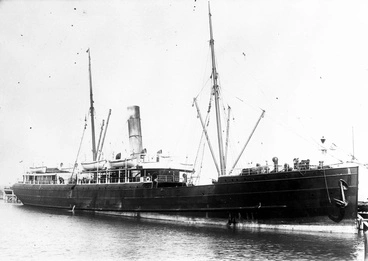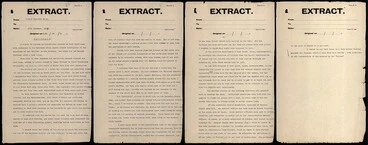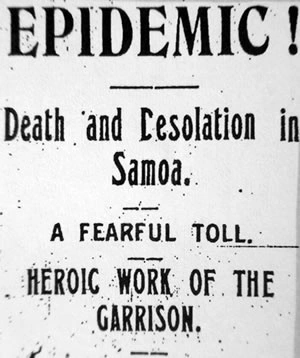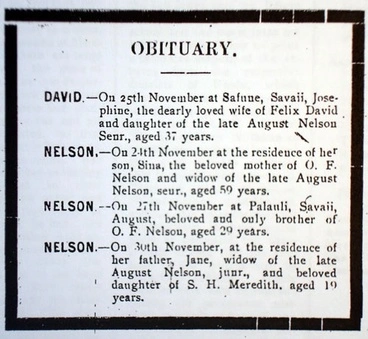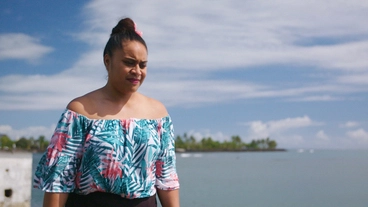The 1918 Influenza Pandemic in Samoa and the Wider Pacific
A DigitalNZ Story by National Library Services to Schools
New Zealand was responsible for the spread of the 1918 influenza epidemic to Samoa and the wider Pacific Islands. This story focuses on how this happened and the disastrous impact it had on the Pacific Island nations.
SS Talune, the ship that brought influenza to Samoa
Manatū Taonga, the Ministry for Culture and Heritage
BACKGROUND
By the end of 1918, a dangerous and contagious strain of flu virus had become a pandemic, killing millions in its wake. With no experience of pandemics, the New Zealand government struggled to find the most appropriate measures and solutions to control the virus. Isolation and quarantine were two of the initial primary measures taken to prevent the spread of the disease. Unfortunately, one oversight was the lack of border control to monitor or curtail travel and trade within the country or internationally.
New Zealand continued its trading activities with New Zealand administered Samoa and others in the Pacific with tragic results.
CONTENTS
This story on The 1918 influenza pandemic in Samoa and the wider Pacific covers the following:
- Influenza shipped to Samoa
- Who was to blame?
- New Zealand's response
- Royal Commission inquiry
- Impact on Samoa
- Prime Minister Helen Clark's apology in 2002
- The pandemic spreads to the wider Pacific
- Glossary
- Quick facts
- Supporting resources
The pandemic in Samoa and the work of the New Zealand military garrison in controlling the situation
Archives New Zealand Te Rua Mahara o te Kāwanatanga
INFLUENZA SHIPPED TO SAMOA
On 7 November 1918, the New Zealand passenger and cargo ship Talune arrived at Apia from Auckland. On board were people suffering from pneumonic influenza, a highly infectious disease already responsible for hundreds of thousands of deaths around the world. Although the Talune had been quarantined in Fiji, no such restrictions were imposed in Samoa. Sick passengers were allowed to disembark.
The disease spread rapidly through the islands. Samoa's disorganised local health facilities and traumatised inhabitants were unable to cope with the magnitude of the disaster and the death toll rose with terrifying speed. Grieving families had no time to carry out traditional ceremonies for their loved ones. Bodies were wrapped in mats and collected by trucks for burial in mass graves.
The total number of deaths attributable to influenza was later estimated to have reached 8500, or 22% of the population.
Source: The 1918 influenza pandemic - Influenza in Samoa, NZHistory
WHO WAS TO BLAME?
Survivors blamed the New Zealand Administrator, Lieutenant-Colonel Robert Logan, for failing to quarantine Talune and for rejecting an offer of medical assistance from American Samoa. A Royal Commission called to enquire into the allegations found evidence of administrative neglect and poor judgement.
Logan seemed unable to comprehend the depth of feeling against him and his administration. He left Samoa in early 1919 and did not return. The new Administrator, Colonel R.W. Tate (1920-23), was left to cope with survivors' immense grief and ongoing resentment.
"[It is] temporary and, like children, they [Samoans] will get over it provided they are handled with care... They will later on remember all that has been done for them in the previous four years..." 1.
1. Logan's report on the administration of Western Samoa, 8 August 1919, IT 1/1/1D
Source: The 1918 influenza pandemic - Influenza in Samoa, NZHistory
Residence of the New Zealand administrator of Samoa, Robert Ward Tate
Alexander Turnbull Library
Colonel Robert Logan and Colonel Paterson, Western Samoa
Alexander Turnbull Library
[Colonel Robert Logan and his staff, Western Samoa]
Alexander Turnbull Library
NEW ZEALAND'S RESPONSE
Newspaper in praise of the garrison stationed in Samoa
Manatū Taonga, the Ministry for Culture and Heritage
Rather than accept responsibility for the influenza pandemic, New Zealand officials praised the efforts of their personnel in the face of adversity. At the same time, they condemned Samoa’s inhabitants for failing to help themselves. In this way, New Zealand was able to satisfy itself that, despite the tragedy, it was still best placed to govern Samoa.
Source: Reporting Samoa's influenza pandemic, NZHistory
ROYAL COMMISSION INQUIRY
A Royal Commission called to enquire into the allegations found evidence of administrative neglect and poor judgement.
Source: The 1918 influenza pandemic - Influenza in Samoa, NZHistory
Newspaper articles
Newspapers reported on the appointment of a Royal Commission and also on the introduction of influenza into Samoa, the impact of steamer Talune in spreading the virus, and the negligence caused by persons in the service of the Crown.
DISEASE-SWEPT SAMOA. (Northern Advocate, 10 May 1919)
National Library of New Zealand
INFLUENZA. (Taranaki Daily News 1-8-1919)
National Library of New Zealand
THE SAMOAN EPIDEMIC. (Otago Daily Times 18-8-1919)
National Library of New Zealand
IMPACT ON SAMOA
Loss of family members in a short span of time
Manatū Taonga, the Ministry for Culture and Heritage
The total number of deaths attributable to influenza was later estimated to have reached 8500, or 22% of the population. According to a 1947 United Nations report, it ranked as ‘one of the most disastrous epidemics recorded anywhere in the world during the present century, so far as the proportion of deaths to the population is concerned’.
The influenza pandemic had a significant impact on New Zealand's administration of Samoa. Many older matai died, making way for new leaders more familiar with European ways. For survivors, the incident was seared into memory. It became the foundation upon which other grievances against the New Zealand administration would be built.
Source: The 1918 influenza pandemic - Influenza in Samoa, NZHistory
1918: Samoa and the Ship of Death (Talune)
NZ On Screen
Remembering the lives lost in the influenza epidemic in Samoa
Radio New Zealand
PRIME MINISTER HELEN CLARK'S APOLOGY IN 2002
Le Ageagea o Tumua gifted to New Zealand Prime Minister Helen Clark for her public apology in June 2002
Museum of New Zealand Te Papa Tongarewa
Prime Minister Helen Clark's apology in 2002
On behalf of the New Zealand Government, I wish to offer today a formal apology to the people of Samoa for the injustices arising from New Zealand’s administration of Samoa in its earlier years, and to express sorrow and regret for those injustices.
Helen Clark, speech at State Luncheon, Apia, Samoa, 4 June 2002
Source: New Zealand in Samoa - Towards independence, NZHistory
The reasons for the apology
Samoa was under New Zealand’s administration until 1 January 1962 when it achieved independence. However, Independence day is celebrated on 1 June every year.
In June 2002 New Zealand Prime Minister Helen Clark visited Samoa to celebrate the country’s 40 years of political independence. While she was there, she made a public apology on behalf of New Zealand for events that took place during New Zealand’s administration from 1914 to 1962.
One event was the outbreak of the influenza pandemic in 1918 introduced to Samoa via infected people onboard the ship, SS Tulane. This caused thousands to die in Samoa.
The other event the Prime Minister apologised for occurred on 28 December 1929. On that day New Zealand police fired on followers of the Mau Movement, a non-violent movement advocating Samoan independence. Eleven Samoans were killed.
New Zealand to apologise to Samoa for past injustices
Radio New Zealand
THE PANDEMIC SPREADS TO THE WIDER PACIFIC
The SS Talune left Auckland in October 1918 when the second wave of influenza was rampant in New Zealand. Besides Samoa, the ship went on to dock in Fijian and Tongan ports. Within weeks both Tonga and Fiji lost significant proportions of their population.
Talune – based on the 1918 Influenza Pandemic Tragedy in Samoa
Radio New Zealand
EPIDEMIC IN FIJI. (Feilding Star, 20 December 1918)
National Library of New Zealand
INFLUENZA IN ISLANDS (Thames Star, 27 December 1918)
National Library of New Zealand
INFLUENZA IN TAHITI (Evening Post, 26 December 1918)
National Library of New Zealand
PACIFIC ISLANDS DECLARED INFECTED. (Wanganui Chronicle, 28 November 1918)
National Library of New Zealand
GLOSSARY
Definitions below have been taken from theOxford Learner's Dictionary.
epidemic - a large number of cases of a particular disease or medical condition happening at the same time in a particular community.
pandemic - a disease that spreads over a whole country or the whole world.
traumatised - to shock and upset somebody very much, often making them unable to think or work normally.
QUICK FACTS:
- Fiji lost around 5.2%, Tonga 4.2 to 8.4% and Tahiti 10% of their population to the 1918 influenza.
- American Samoa, less than 50 km from Western Samoa recorded no deaths from pandemic because of isolation and limited trade.
- New Zealand Administrator of Samoa, Colonel Robert Logan refused help from the Governor of American Samoa that may have lowered the death toll.
- Colonial medical staff in Fiji did not take the risk of the 1918 pandemic seriously and avoided quarantine measures due to economic pressures.
- Vaimea is an example of the many places in Samoa where graves were hastily dug to accommodate the mass burial of those who perished in the pandemic.
- The Samoan Epidemic Commission blamed New Zealand for lack of notification of the pandemic, Colonel Logan for not guaranteeing the Talune, and Captain Mawson for not declaring the illness on board the Talune.
- The spread of the 1918 influenza pandemic into Samoa by New Zealand and the killing of 11 Samoans by New Zealand police in Apia in December 1929, served as catalysts for the fight for Samoan independence
- UNICEF and the World Health Organisation are supporting Pacific Island nations to prepare for the COVID-19 threat by providing them with medical equipment like infrared thermometers and personal protective gear (PPE).
SUPPORTING RESOURCES
Centenary of the 1918 influenza pandemic — in this video clip, Mele Ioelu from Samoa speaks about the tragedy she witnessed as a young girl.
Disease and the Colonial Narrative— the 1918 influenza pandemic in Western Polynesia.
Epidemic: the story of Robert Logan— the suffering of Samoa was increased by the incompetent and insensitivity of Lieutenant Colonel Robert Logan, the New Zealand administrator of Samoa in 1918.
EPIC — find more information on this topic on EPIC. Databases recommended: Australia/New Zealand Reference Centre Plus. School login maybe required.
How NZ took influenza to Samoa, killing a fifth of its population 0151 — when the infected steamship Talune docked in Apia there was no imposed quarantine.
Influenza pandemic 1918 — this page from Many Answers will guide you to reviewed websites and databases on the influenza pandemic in New Zealand and around the world.
The influenza epidemic of 1918 in Western Samoa — an extract from the book The Journal of Pacific History, by Sandra Tomkins, 1992.
Modelling the Impact of Pandemic Influenza on Pacific Islands— statistics and data on the impact of the influenza pandemic on the island nations.
1918 Pacific influenza crisis— the fact that Samoa did not know about viruses, and the SS Talune was given a clean bill of health were two reasons influenza had a devastating impact on Samoan society.
The 1918 Influenza Epidemic in Sāmoa and the Sāmoan Church (LMS)— this paper looks at the possible role of the church in the spread of disease.
NZ marks 100 years since the flu outbreak in Samoa— New Zealand's Foreign Affairs Ministers Winston Peters announced support for a memorial to mark 100 years since the deadly outbreak of influenza in Samoa.
Paradise locked — despite being less than 50 km from Western Samoa, American Samoa successfully remained untouched by the infection for years.
Right now, our islands need us to stay away— the role that New Zealand played in spreading the past epidemics means we need to careful to ensure that past mistakes are not repeated.
Tales of time – sickness in the boat — Michael Field on eye witness accounts of the spread of influenza and the suffering of the Samoan people.
This story was curated and compiled by Te Puna Mātauranga o Aotearoa | National Library of New Zealand, Services to Schools staff, April 2020.
